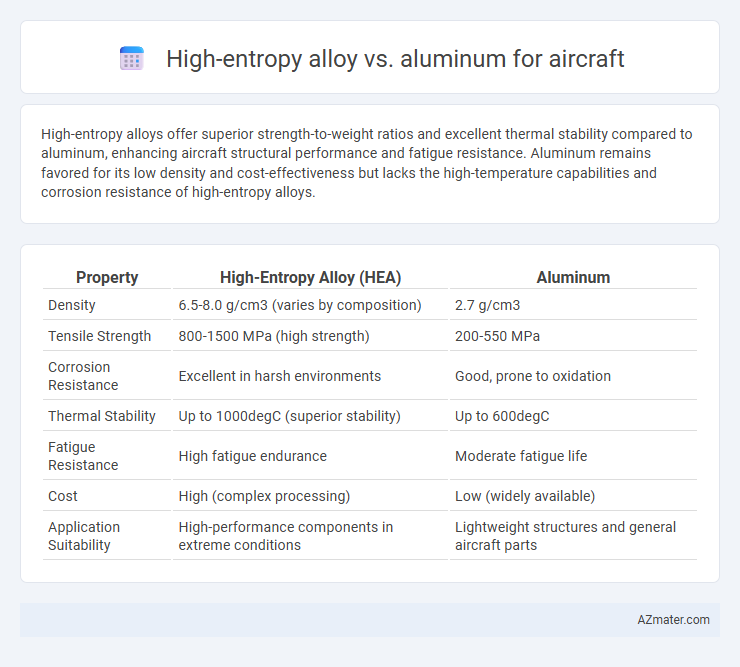High-entropy alloys offer superior strength-to-weight ratios and excellent thermal stability compared to aluminum, enhancing aircraft structural performance and fatigue resistance. Aluminum remains favored for its low density and cost-effectiveness but lacks the high-temperature capabilities and corrosion resistance of high-entropy alloys.
Table of Comparison
| Property | High-Entropy Alloy (HEA) | Aluminum |
|---|---|---|
| Density | 6.5-8.0 g/cm3 (varies by composition) | 2.7 g/cm3 |
| Tensile Strength | 800-1500 MPa (high strength) | 200-550 MPa |
| Corrosion Resistance | Excellent in harsh environments | Good, prone to oxidation |
| Thermal Stability | Up to 1000degC (superior stability) | Up to 600degC |
| Fatigue Resistance | High fatigue endurance | Moderate fatigue life |
| Cost | High (complex processing) | Low (widely available) |
| Application Suitability | High-performance components in extreme conditions | Lightweight structures and general aircraft parts |
Introduction to High-Entropy Alloys and Aluminum in Aviation
High-entropy alloys (HEAs) are advanced materials composed of five or more principal elements in near-equal atomic ratios, offering exceptional mechanical strength, corrosion resistance, and thermal stability, making them promising for aerospace applications. Aluminum alloys have long been the backbone of aircraft structures due to their lightweight, high strength-to-weight ratio, and excellent fatigue resistance. Comparing HEAs and aluminum in aviation involves evaluating HEAs' superior high-temperature performance and wear resistance against aluminum's proven track record in lightness and manufacturability.
Composition and Microstructure Differences
High-entropy alloys (HEAs) consist of five or more principal elements in near-equiatomic proportions, resulting in complex solid solution microstructures, whereas aluminum alloys primarily contain aluminum with smaller amounts of elements like copper, magnesium, and silicon, forming simpler microstructures such as single-phase solid solutions or precipitation-hardened phases. HEAs typically exhibit stabilized multi-phase microstructures including FCC, BCC, or mixed phases with high configurational entropy, promoting enhanced mechanical properties and corrosion resistance. In contrast, aluminum alloys rely on phase precipitation and grain refinement for strength, with microstructures that are less complex but tailored for lightweight performance in aircraft applications.
Mechanical Properties: Strength and Toughness
High-entropy alloys (HEAs) exhibit superior mechanical properties compared to aluminum, boasting higher strength and enhanced toughness essential for aircraft structural components. HEAs maintain excellent strength at elevated temperatures, surpassing aluminum alloys that typically weaken under such conditions. The combination of high tensile strength and fracture toughness in HEAs contributes to improved fatigue resistance and structural integrity, offering significant advantages in aerospace applications where weight and durability are critical.
Weight Considerations and Density Comparison
High-entropy alloys (HEAs) exhibit densities typically ranging from 7.5 to 9.0 g/cm3, which is significantly higher than aluminum's density of about 2.7 g/cm3, posing weight challenges for aircraft applications where reducing mass is critical. Aluminum's low density contributes to fuel efficiency and enhanced payload capacity, making it a preferred material despite HEAs' superior strength and thermal stability. Weight considerations thus favor aluminum in aerospace structures, while HEAs are often limited to components requiring high wear resistance or elevated temperature performance.
Corrosion Resistance in Aerospace Environments
High-entropy alloys exhibit superior corrosion resistance compared to aluminum alloys in aerospace environments due to their unique multi-element composition, which forms stable passive oxide layers that protect against oxidation and saltwater exposure. Aluminum, while lightweight and widely used, tends to suffer from pitting corrosion and stress corrosion cracking under harsh marine and atmospheric conditions. High-entropy alloys offer enhanced durability and longer service life, reducing maintenance costs and improving aircraft safety in corrosive aerospace settings.
Fatigue Performance Under Cyclic Loading
High-entropy alloys exhibit superior fatigue performance under cyclic loading compared to aluminum, due to their complex microstructure that enhances resistance to crack initiation and propagation. Aluminum alloys, while lightweight and corrosion-resistant, tend to suffer from reduced fatigue life when exposed to repeated stress cycles common in aircraft operations. The enhanced mechanical properties of high-entropy alloys make them promising candidates for critical aircraft components requiring long-term durability under cyclic loads.
Thermal Stability and High-Temperature Performance
High-entropy alloys (HEAs) exhibit superior thermal stability and high-temperature performance compared to traditional aluminum alloys, maintaining mechanical strength and resisting oxidation at temperatures above 800degC. Aluminum alloys typically degrade in strength and form oxide layers when exposed to elevated temperatures around 200-300degC, limiting their use in high-temperature aircraft components. The enhanced thermal resistance and phase stability of HEAs contribute to improved durability and efficiency in aerospace applications requiring extreme heat tolerance.
Manufacturability and Processing Challenges
High-entropy alloys (HEAs) present significant manufacturability challenges compared to aluminum due to their complex multi-element compositions requiring advanced processing techniques like rapid solidification or additive manufacturing to achieve desired microstructures. Aluminum alloys benefit from well-established casting, forging, and machining processes with predictable behavior, making them more cost-effective and easier to scale for aircraft production. The high melting points and segregation tendencies of HEAs necessitate precise control during fabrication, complicating their integration into conventional aerospace manufacturing workflows.
Cost Analysis and Material Availability
High-entropy alloys (HEAs) present higher initial costs due to complex manufacturing processes and scarce raw materials compared to aluminum, which benefits from well-established extraction and fabrication infrastructure reducing overall expenses. Aluminum's widespread availability and recycling efficiency lower lifecycle costs significantly, whereas HEAs face challenges in material sourcing and upscaling production for aerospace applications. Cost analysis must also consider aluminum's proven supply chain reliability against HEAs' emerging status, which currently limits their cost-effectiveness for commercial aircraft manufacturing.
Future Prospects and Applications in Aircraft Design
High-entropy alloys (HEAs) offer superior mechanical strength, corrosion resistance, and thermal stability compared to traditional aluminum alloys, making them promising candidates for advanced aircraft components subjected to extreme conditions. Emerging research highlights HEAs' potential to reduce aircraft weight while enhancing durability, contributing to fuel efficiency and lower maintenance costs in next-generation aerospace designs. Integration of HEAs in critical structures such as turbine engines, airframes, and landing gear could redefine performance standards and drive innovation in future aircraft manufacturing.

Infographic: High-entropy alloy vs Aluminum for Aircraft
 azmater.com
azmater.com